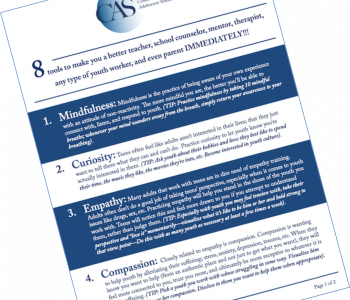

Sam Himelstein, PhD
Sam Himelstein is the founder and CEO of the Center for Adolescent Studies, Inc. He is passionate about working with youth and training the professionals that serve them.
Mindful classroom management: A tried and true technique for getting youth back on track.
As I walked into the juvenile hall on a Thursday night to teach a mindfulness class, I contemplated the evening’s agenda. It was 2007 and I worked for the Mind Body Awareness Project as a mindfulness instructor; at the time we had no set curriculum. It was up to us as facilitators to develop our own topics for each class. “What am I gonna do tonight?” I began to think to myself. The guard at the front door interrupted my thoughts:
The unit you teach your class in has been on lockdown for 3 days. We just let them off an hour ago but they’re still in their rooms. You’d be their first program. Are you sure you want to still teach the class?
The officer was alluding to the fact that the youth would be bouncing off the walls with energy. I naively thought it wouldn’t be a big and deal and agreed to teach the class. Usually I’d have about 8-12 youth in my class. This night however, 22 showed up!
I rang my meditation bell as I usually do to get the attention of the youth and start the class. I began to introduce myself, and what the class was about, to youth who were new to the program. Suddenly I realized that most, if not all, of the youth in the room were not listening to me. They’d been cooped up in their rooms for the last 3 days and this was the first time they were let out other than to shower. To say these young men had pent-up energy would be a serious understatement!
Then something amazing happened. In the moment, I didn’t quite know it was coming. In reflection it really feels like something was being channeled through me. I simply said with the softest but audible tone, “Hey fellas, can we please be quiet?” (This was a group of all young men). No change. No one appeared to even hear me. I said it again in the same soft tone, “Hey fellas, can we please be quiet?” Again, nothing. A third time. Then a fourth time. Finally one of the youth noticed I was trying to get the class started and said in a loud voice, “He’s trying to start the class. Be quiet!” A few other youth stopped side talking. I kept asking the same question in that soft tone, “Hey fellas, can we be quiet?” Ten times. Twelve times. And then after about the fifteenth time, the whole group of 22 youth was quiet and looking at me, waiting for the class content. When I tell this story in trainings sometimes therapists and other educators have a look on their face like “15 times! That is extreme!”
It only took 55 seconds.
Literally in less than a minute this technique helped the group completely refocus in a non-combating way without reprimanding anyone individually or without delivering a nasty tone. The reason I say it felt as though something was being channeled through me is because I felt no ego being triggered while I was asking the group to refocus. I easily could’ve noticed that I was not getting the feedback I initially wanted (the group refocusing after 1-2 of those questions) and raised my voice, “HEY FELLAS, CAN WE PLEASE BE QUIET?” Yes, this might have helped them refocus faster, but it would’ve reinforced myself as “just another adult” who yells and asserts authority if I don’t get my way.
While I didn’t quite understand how much of a gem this technique would become in my work with youth at the time, I have reflected on it and its value for years. This Group Refocusing Technique, as I like to call it, has two main effects that enhance any therapy group or classroom: 1) It’s a great group/classroom management technique when the youth get off track or become unfocused in any way. Let’s face it, this happens with teenagers. It’s also okay. They’re young and have an abundance of neurons firing every moment in their brains. As professionals we must have a way to intervene without asserting authority and reinforcing the same dynamic of adults yelling when they want youth to do something. And 2) this technique promotes mindful self-awareness. After asking the group, “Hey fellas, can we be quiet?” we have a moment or two of silence once every one settles down. A pause, where I tell the group:
It’s okay to get off track sometimes. That’s the nature of the mind. Just know that we can always pause like this, like hitting the refresh or reset button, and get back on track.
Sometimes I’ll even add “Hey fellas, can we be quiet and take a few breaths?” This is a way to promote mindfulness into your group or class without even saying the word “mindfulness” or “meditation.” And it’s a great way to non-judgmentally refocus the group without chastising any one individual.
The Key to Mindful Group Refocusing
The key to successfully implement this technique is to have an enhanced awareness of yourself. In order to not raise your voice if the group doesn’t get quiet after the first time you implement the technique, you must think of the technique as your own mindfulness practice. You must practice mindful speech and be aware of any reactions if you don’t settle the group down on the first attempt. This will help you to not become reactive and raise your voice. That’s the key, and the youth will appreciate it.
Since the above experience almost 10 years ago, I have implemented this group refocusing strategy into every group I facilitate, whether in a therapy or classroom setting, and included it formally into the Mindfulness-Based Substance Abuse Treatment 12-Session Curriculum for teens, an evidence-based program I co-developed. It’s important to build this technique into the foundational agreements/expectations you create with your youth during your first group (Tips for creating group agreements can be found here). I usually present this group refocusing technique as the final agreement during that first class in some form of the below (I encourage you to edit to your liking and authentic voice):
The last agreement I want us to agree to is what I like to call the refocusing technique. Even though we agreed to all the other agreements, most of us know that sometimes we get off track. Sometimes we’ll be talking when someone else is talking and not upholding that one mic’ agreement we just talked about. Or sometimes we might get upset and not uphold our agreement of respect. These things happens. We’re human beings. We make mistakes sometimes. What I’d like to do however, is that when something like that happens, when we get off track, I’m just going to gently say to the group, “Hey fellas, can we be quiet?” Or “Hey fellas, can we take a few breaths?” Or I might just ring this meditation bell to signify that we need to refocus.
My commitment to you is that I’m never going to yell at you. I’m always going to ask the group to refocus in a tone like this. I’m always going to treat you with respect and dignity.
Is that okay with everyone? That that’s how I’ll deal with it when we get off track?”
And then of course, make sure you get acknowledgement from everyone in the group. Since that night almost 10 years ago, when using the refocusing technique I haven’t had to ask the question more than five times in any one group (and most times don’t even have to use it!). This takes less than 30 seconds! This is because when building the technique into the initial agreements with a group, you can leverage the agreement conversation and actually use the technique. And the group will not be surprised.
Last week I probably had the most rowdy group I’ve had since the night I wrote about above—twelve youth from a maximum-security unit in the juvenile hall where I currently work as a therapist, all highly traumatized. It was the first class where we review group agreements. It was rowdy, and I needed to use the technique even before getting to that part of the agreements. I had to ask the refocusing question 3-4 times on 3-4 separate occasions throughout the group. But still, it worked. Then this week, after the agreements were set, the group was much more focused and responded almost immediately to my refocusing intervention. It was beautiful to see, that with a group of highly triggered and traumatized youth, it helped bring some stability, even if just for a few moments, to the chaos they endure on a daily basis.
In summary:
• Choose a phrase that’s in alignment with your authentic voice and stick to it (“Hey fellas, can we all be quiet and take a few breaths?” worked for me; yours may differ).
• Discuss the group refocusing technique with your group or class when you first meet them
• State that the technique is how you as the facilitator/teacher will respond when the group gets off track
• Commit to not raising your voice and becoming authoritarian (i.e., commit to making it your own mindful self-awareness practice and being intentional every time you use it—and state this explicitly to your group/class)
• Get the whole group to actually agree (make eye contact with everyone and get verbal acknowledgement)
Learn more about mindfulness-based interventions for groups and classrooms through the new course, Mindfulness for Trauma and Addiction: A Self-Paced Daylong for a 5.5 hour introductory + solid foundation to using mindfulness with substance-impacted youth.
Related Posts
2 Simple Tips to Create a Welcoming Trauma-Informed Classroom Space
4 Different Approaches to Leading Groups of Youth

